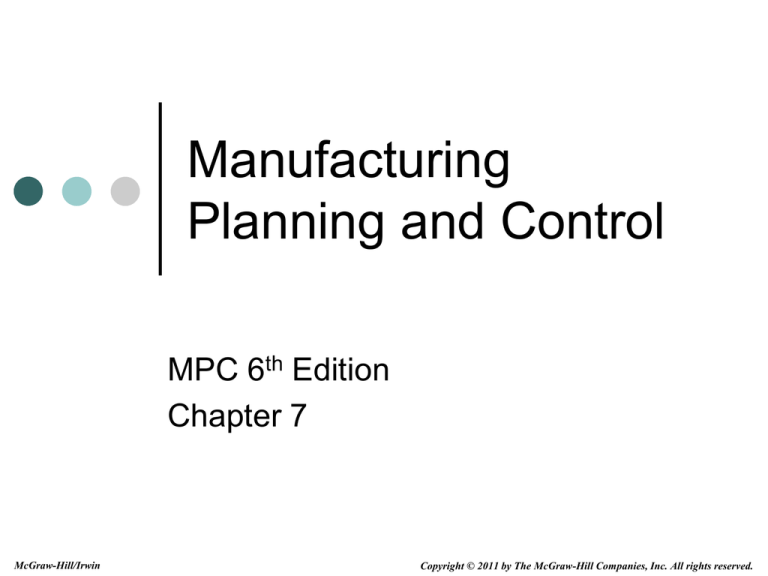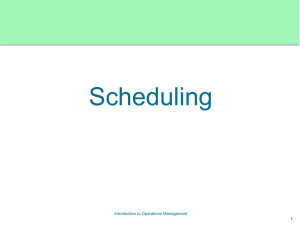
Manufacturing
Planning and Control
MPC 6th Edition
Chapter 7
McGraw-Hill/Irwin
Copyright © 2011 by The McGraw-Hill Companies, Inc. All rights reserved.
Capacity Planning and
Management
Capacity planning and management
addresses two managerial problems:
Matching capacity to plans–by either
providing sufficient capacity to execute
the plan or adjusting the plan to meet
available capacity.
Consider the marketplace implications of
faster throughput times–at the expense
of reduced capacity utilization.
7-2
Agenda
What is Capacity Planning?
Role of Capacity Planning in Master Planning and
Control
Capacity Planning and Control Techniques
Simultaneous Scheduling of Capacity and
Materials
Capacity Management
7-3
Role of Capacity Planning in
Master Planning & Control
The primary objective of capacity planning
techniques is to estimate capacity
requirements early enough to be able to
meet those requirements
Flawless execution of the capacity plan
allows the firm to avoid unpleasant surprises
Insufficient capacity leads to deteriorating
delivery performance
Excess capacity may be a needless expense
7-4
Capacity Planning in the
MPC System
Long Range
Resource
planning
Sales and operations
planning
Demand
management
Resource planning
Rough-cut capacity
planning
Master production
scheduling
Medium Range
Capacity requirement
planning
Short Range
Detailed material
planning
Material and
capacity plans
Finite Loading
Input/output analysis
Shop-floor
systems
Supplier
systems
7-5
Links to other MPC System
Modules
Resource
Planning
• Linked to
sales and
operations
planning
(SOP)
• Converts
SOP data to
aggregate
resource
units
Rough-Cut
Planning
• Linked to
Master
Production
Schedule
(MPS)
• Estimates
capacity
requirements
of MPS
Capacity
Requirements
Planning
• Linked to
material
requirements
planning
(MRP)
• Prepares
detailed
capacity plan
based on
time-phased
material
plans
Finite Loading
• Linked to
material
planning and
shop floor
control
• Considers
adjustment
of plans due
to capacity
utilization
Input/output
Analysis
• Linked to
shop floor
control
• Monitors
actual
consumption
of capacity
during
execution of
detailed
material
planning
7-6
Capacity Planning
Using Overall
Factors (CPOF)
Capacity Bills
Capacity
Planning
and Control
Resource Profiles
Capacity
Requirements
Planning
7-7
Capacity Planning Using
Overall Factors (CPOF)
Simplest rough-cut capacity planning approach
Data inputs from master production schedule
Based on planning factors from historical data
(work center utilization, production standards)
Overall labor- or machine-hour capacity
requirements are estimated from MPS data
Estimate is allocated to work centers based on
historical workloads
Inherent inaccuracies may limit usefulness
7-8
CPOF Example
Total required
capacity =
(33*0.95)+(17*1.
85) = 62.80
Work center capacity = Historical percentage*Total
required capacity
7-9
Capacity Bills
Rough-cut capacity planning method that
provides more direct link to individual end
products
Bill of capacity indicates total standard time to
produce one unit of an end product (by work
center)
Master production schedule data is then used
to estimate capacity requirements for each work
center
Requires more data than CPOF procedure
7-10
Capacity Bill Example
Std. Setup hours
are spread over the
standard lot size
Total hours include
both std. run time
and std. setup time
7-11
Capacity Bill Example
MPS quantities are
multiplied by bill of
capacity to
determine work
center capacity
requirements by
period
7-12
Resource Profiles
Rough-cut capacity planning technique
that includes production lead time
information
Provides time-phased projections of
capacity requirements for individual
work centers
More sophisticated approach but
requires tracking of relatively short time
periods (< 1 week)
7-13
Resource Profile Example
Production of one unit of product A in period 5
requires production activity in periods 3, 4, and 5
and in work centers 100, 200, and 300
7-14
Resource Profile Example
Requirements
(by work center
and period) for
one unit of end
product are
multiplied by
the MPS plan
to determine
capacity
requirements
These
requirements
are then
summed over
all periods to
finalize the
process
7-15
Capacity Requirements
Planning (CRP)
Capacity requirements planning differs from
the rough-cut planning procedures
Utilizes time-phased material plan from MRP
Takes into account materials in inventory
Accounts for the current status of work-inprocess
Accounts for service parts and other demands
not accounted for in the MPS
Requires more inputs and more
computational resources
7-16
Detailed
MRP Data
Capacity Requirements
Planning Example
Scheduled/planned
quantity multiplied
by processing time
for work center
This process is repeated for each work center to complete the plan
7-17
Scheduling Capacity and
Materials Simultaneously
Capacity requirements planning doesn’t
consider capacity when planning materials
Assumes that capacity can be adjusted, given
sufficient warning
Planning capacity and materials at the same
time allows construction of a plan that works
within current capacity constraints
7-18
Finite Capacity Scheduling
Simulates job order start and finish times in
each work center
Establishes a detailed schedule for each job
in each work center
When a work center’s capacity is not
sufficient for all planned jobs, prioritization
rules determine which jobs will be shifted to
later times
7-19
Finite Capacity Scheduling
Product A
does not
consume all
available
capacity
Combination of
all products
consumes all
available
capacity in
several periods
Planned
orders are
shifted to
stay within
capacity
limitations
7-20
Work Center Scheduling
Vertical Loading–each work center is
scheduled job by job without consideration of
other work centers
Increases capacity utilization but may result in
more partial job completion
Horizontal Loading–jobs are scheduled through
all work centers in order of priority
Lower capacity utilization but generally a higher
proportion of jobs are completed in a shorter
time span (higher customer service levels)
7-21
Finite Capacity Scheduling
The FCS plan is a simulation
Randomness leads to actual times that don’t
match scheduled times
Should the work center wait for a job that isn’t
available on time (idleness = lost capacity)
Over time, the accuracy of the plan deteriorates
Frequent rescheduling may be needed to
maintain accuracy
Rescheduling process is computationally
expensive
7-22
Advanced Production
Scheduling (APS)
Expands Finite Capacity Scheduling to the
entire product structure (end products and
sub-assemblies)
Can lead to a significant reduction in lead
times
Requires accurate scheduling parameters,
flawless execution, and prompt recovery
from any problems
7-23
Capacity Management
Management and Capacity
Planning/Utilization
Capacity
monitoring
with
input/output
control
Managing
bottleneck
capacity
Capacity
planning in
the MPC
system
Choosing
the
measure of
capacity
Choice of
specific
techniques
Using the
capacity
plan
7-24
Capacity Monitoring with
Input/Output Control
Planned inputs are determined by the capacity
planning process
Planned outputs depend upon the nature of the
work center
Capacity-constrained–planned output is determined by
the processing rate of the work center
Non-capacity-constrained–planned outputs match
planned inputs
Differences between plan and actual must be
addressed (management by exception)
7-25
Managing Bottleneck Capacity–
Theory of Constraints
Determine bottleneck work centers
Rough-cut capacity planning
Capacity resource planning
Look for quick solutions to eliminate bottlenecks
Expand capacity
Alternate routings
Concentrate scheduling efforts on managing bottleneck resources
Schedule jobs that run through bottlenecks
separately from non-bottleneck jobs
Use finite scheduling for bottleneck jobs, with
horizontal loading and back scheduling for the
most critical
7-26
Capacity Planning in the
MPC System
Short-term capacity planning problems can
be reduced by well-executed production and
resource planning
Efficient use of sufficient capacity by a good
shop-floor system reduces capacity issues
7-27
Choosing the Measure of
Capacity
Capacity can be measured in many ways
Labor hours, machine hours, physical units, monetary
units
The firm’s needs and constraints should determine
the capacity measure
Trends
Shrinking portion of direct labor
Less clear distinctions between direct and indirect labor
Reduced ability to change labor capacity
Outsourcing
Flexible automation/cellular technologies
7-28
Choice of a Specific Planning
Technique
Rough-cut methods
CPOF
Capacity bills
Resource profiles
Most general
Widely applicable
Easier to implement but
less powerful
Useful in JIT situations
Capacity
requirements
planning
APS Systems
Requires more data
and computational
effort
Only applicable in
conjunction with MRP
Unnecessary under JIT
Highest levels of effort
High levels of accuracy
possible with good data
and flawless execution
7-29
Using the Capacity Plan
Two broad choices are available when actual
capacity and plan are mismatched
Change capacity–reduce or increase capacity
as indicated (within constraints)
Revise material plan–change requirements
and/or timing to match available capacity
The amount of material that can be produced
is limited by the available capacity,
regardless of the material plan
7-30
Principles
Capacity plans must be developed concurrently with
material plans if the material plans are to be
realized.
Capacity planning techniques must match the level
of detail and actual company circumstances.
Capacity planning can be simplified in JIT
environments.
Better resource and production planning processes
lead to less difficult capacity planning processes.
Better shop-floor systems reduce the need for shortterm capacity planning.
7-31
Principles
More detailed capacity planning systems demand
more data and database maintenance.
When capacity does not match the requirements, it
isn’t always capacity that should change.
Capacity must be planned, but use of capacity must
also be monitored and controlled.
Capacity planning techniques can be applied to
selected key resources.
Capacity measures should reflect reasonable levels
of output from key resources.
7-32
Quiz – Chapter 7
Which capacity planning activities are considered long-range
plans? Short-range plans? Medium-range plans?
Resource planning is most closely linked with which MPC
element?
The capacity planning using overall factors (CPOF) technique
is likely to perform poorly in a just-in-time (JIT) environment?
(True/False)
Capacity requirements planning (CRP) ignores current
finished goods and WIP inventory? (True/False)
According to the Theory of Constraints, bottleneck and nonbottleneck work centers should be managed similarly?
(True/False)
7-33










